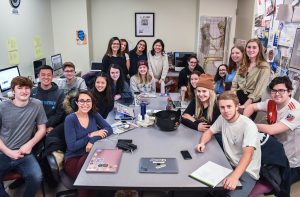Q&A: Berkeley Beacon Editor-in-Chief Maya Gacina Talks Shop
This semester, Maya Gacina ’21 became the new editor-in-chief of the Berkeley Beacon. Emerson Today’s David Ertischek ’01 talked with Gacina about her goals for the Beacon, her career, and what she’s reading. This interview has been edited for length.
Q: How did you decide to come to Emerson College?
Gacina: I was deciding between UNC-Chapel Hill and Emerson, and I didn’t realize until I got accepted into Emerson that it is the number one journalism school. I was editor-in-chief of my high school paper. And I couldn’t see myself in any other career path than journalism.
Q: What’s your major?
Gacina: Journalism. I’m minoring in Women’s, Gender & Sexuality Studies.
Q: How long have you worked with the Berkeley Beacon?
Gacina: Two years. I started basically on my first day at Emerson. It was an intimidating first day. At first I came into this…not cocky, but having more confidence then I should have because I was editor-in-chief in high school. I thought I knew more about it.
The Beacon impressed me because it was a strong paper and everyone was so talented and I was hoping they’d welcome me into their family. They did. I had to work my way into it. I was going to story assignment meetings every Monday.
Q: How does someone get to be editor-in-chief?
Gacina: Basically, you have to have experience on the Beacon. They prefer news experience. I was the enterprise news editor last semester. They decided I was the right choice after Shafaq [Patel] left.
It was more of a nomination process. They have the whole newsroom raise their hands for who they want to nominate for the next editor-in-chief. The day of the nominations one of the managing editors said I should nominate myself. I wasn’t sure I could be capable of being editor-in-chief. Someone else nominated me so I didn’t have to nominate myself because that would’ve been awkward… I was interviewed by Shafaq Patel and two managing editors, Kyle Labe and Monika Davis.

Q: What are you excited about being the editor-in-chief?
Gacina: I am excited about finally being able to contribute to editorials. I always wanted to do that because it’s a good way to communicate to people reading our paper, Emerson students, faculty, and staff. It humanizes us, in a way. We’re here and we’re people, too.
I’m excited because it’s online daily, and I will be continuing that as best as we can, and producing more multimedia [content], more videos, more podcasts. We have a big staff this semester, most open positions were filled. There’s about 43 people on staff, that’s including copy editors, and that’s not just people in the newsroom.
Q: What would you like to write about on the Beacon?
Gacina: I want to bring more coverage to national topics and see how they’re directly or indirectly affecting students, faculty, and staff. One article we just did was about proposed Title IX policy changes because [U.S. Secretary of Education] Betsy DeVos presented proposals about how all colleges would go about Title IX cases. We do Beacon Breakdowns and break down an intimidating topic into more accessible words. We have sources from the college who explain what’s going to happen because they deal with it mostly. We’re here for four years, but they’ve been here longer.
Q: Outside of the Beacon what would you like to write about? What would you like to write about after the Beacon?
Gacina: Outside of the Beacon I’m interested in investigative journalism. Maybe I would like to look at power structures at certain corporations, companies, and institutions. I want to hopefully travel and find out what other stories are out there and what issues still need to be talked about.
Q: What news sources do you read?
Gacina: I read The New York Times, I listen to NPR, I read The Washington Post. I look at other college campus publications, not as competition, but for stories. All colleges students can be affected by the same things. It’s important to see what others are covering and maybe what we should cover next.
Q: How about social media?
Gacina: I use Twitter. I honestly didn’t use Twitter until I started my journalism degree. I didn’t think it was a tool at first. It’s useful to find news and also give a platform to the Beacon and myself so people can see what we wrote.
Q: What would be your dream job?
Gacina: My dream job is honestly working for The New York Times. I’ve always loved New York, it’s a hub for news and there are so many unique human interest pieces. My dream job is being a full-time journalist and hopefully getting paid well, but that might be a stretch.
Categories